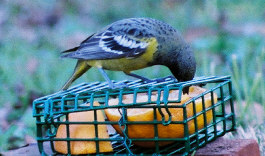|
This was a beautiful addition to the yard. My family and I found and photographed this bird in Thomaston, GA, back
in Nov, 2002. I didn't own a camera at the time, but was able to borrow a friend's 35mm.
Eric Beohm

The thrill of discovery coupled with the joy of backyard birding can produce some unforgettable moments.
A birder's yard is a personalized space where invitations are extended to the rare and the beautiful.
There is a certain pleasure of being aware of the birds in your yard, whether it be a resident
bluebird on a power line or the distant sound of Sandhill Cranes. I have been blessed to record over a hundred and fifty birds
in my yard just this year. My favorites being American Bittern, Common Loon, Alder Flycatcher, Swainson's Hawk, and Inca Dove.
Interestingly, the last two are not even on the official state list for Georgia.
My parent's yard in Thomaston, Georgia has also produced some amazing rarities over the years for
us. Just a few of which have included Black Rail, Northern Saw-whet Owl, Bell's Vireo, Swallow-tailed Kite (in February),
and the last accepted sighting of Bewick's Wren in Georgia. It appears that a yard can be a hangout for cardinals and such
or a pit stop for the extraordinary.
This month a Scott's Oriole was found, identified, and photographed by Richard Beohm, Rose Beohm,
Michael Beohm, and myself. The bird was first seen November 3, 2002 and remained through November 8th. For several days it
frequented a persimmon tree there in my parent's yard located in Upson County, Georgia. (Oddly enough, this is the same tree
where we found and documented an "Audubon's Warbler" one winter.) I managed to borrow a camera, knowing that the oriole would
need to be photographed if possible. Over the next three days the wet weather made finding the bird difficult. Finally on
November 8th after constructing a blind and placing orange halves at the feeder. I was able to take detailed photographs at
close range of the bird. We then reported it through the proper channels, but it did not appear again.
The experts that I and my family consulted with determined that the bird was indeed a Scott's Oriole.
Their consensus was that this is the rarest bird ever documented in Georgia. Besides two records along the Mississippi River,
this is the first record for eastern North America.
Description
The bird is similar to the illustration in the "National Geographic Field Guide to the Birds of
North America" third edition of the Scott's Oriole first spring male.
- The bill is very long and has a shape that is only consistent with Scott's and not Baltimore or
Orchard.
- The underparts are yellow with no hint of orange that I could see. Even when using a very nice
spotting scope from thirty feet away. (Also there was no orange on any part of the bird.)
- Above the top wingbar is a yellow patch like shown for the breeding male.
- The back is grayish-green with dark streaks. The black bib is similar to the illustration.
- The tail is greenish and yellowish. It is similar to the illustration, with a hint of the adult
males tail pattern. Note that this pattern is opposite to that of a Baltimore Oriole.
- I was very pleased to see faint white tail spots at the end of the tail. This was hard to photograph,
but I think I was able to do it.
- The length of the bird is consistent with Scott's. I compared the length to other birds and certain
physical objects. The size excludes Orchard and probably Baltimore.
- I heard the bird call twice. It gave a harsh "chuck" call. This should exclude Baltimore Oriole.
I did not ever hear the bird give a chatter which is characteristic of Orchard and Baltimore.
|

